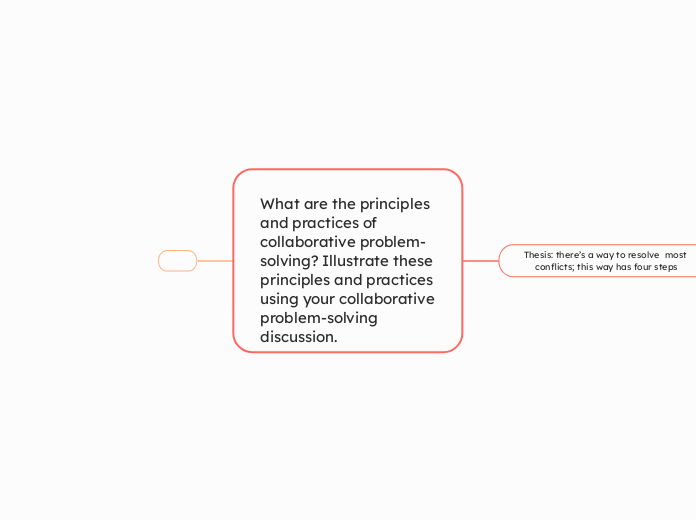What are the principles and practices of collaborative problem-solving? Illustrate these principles and practices using your collaborative problem-solving discussion.
Thesis: there’s a way to resolve most conflicts; this way has four steps
Step 1: Recognize and connect with the humanity of the other.
Principle: Make the other person feel your empathy, care, and connection.
Practice: To connect with the humanity of the other person, ask him plainly to explain his needs and interests concerning the problem and then listen empathetically without interrupting.
Own illustration: In my own conflict, my dad and I disagreed about…. how to put away the recycling. I asked him: “Dad, please explain your needs and interests …”.
And I asked him to connect those needs and interests to the problem at hand and I also summed up his needs and checked to see whether I had done so correctly.
Step 2: Identify the needs and interests of both parties.
Principle: list the needs of both parties.
Separating needs from positions
Two forms of communication
Empathetic listning
Self-assertion
Practice: Write down the other person needs. Use self assertion to say my needs. Make two lists of needs one for each person.
Own illustration:
Some of my needs were:
1. To relax a little after getting home from school, before doing my homework
2. To eat dinner at night before going to bed
3. To shower and go to school right away in the morning.
Some of my partner’s needs were
1. He wants the recycling to be put out.
2. He doesn’t want the recycling piling up at the door for many days.
3. He doesn’t want the house to look like a rubbish dump.
Step 3: Brainstorm ways to meet the needs of each party.
Principle: Brainstorm ways to meet needs of each party.
Lots of ideas
No judgement
Practice: Talk together and list all the needs that both parties have.
Own illustration: 1. We can put the recycling refuse in the garage. Dad said “I don’t want refuse in the
garage, and the garage is far from the shed with the garbage and recycling”.
2. I could take the recycling out as soon as I come home from school. That way I wouldn’t take a lot of
time away from relaxing, eating dinner, homework, and so on.
3. I could also take each new piece of recycling refuse outside right away so that there is no piling
up. I said “I don’t want to be running back and forth in the cold all the time.”
4. We can get small paper bins or stiff paper bags and label them “cans”, “glass”, “plastic”, etc. So the recycling can get sorted right away by everybody in the house.
Step 4:Select a solution for maximum gain.
Principle: Select a solution for maximum gain.
Common ground:
Practice: Pick a solution that meets each party’s needs without compromising.
Own illustration: We selected solution 4.
It met my needs because
(1) It allowed the recyclables to be sorted by everyone in the house automatically. Then, I could just run out quickly without having to sort anything and right away put every recyclable into its main bin outside.
(2) I spent less time in the cold.
(3) I spent less time taking the recycling out and so I had more time for homework, dinner, etc.
It met my partner’s needs because
(4)The recycling didn’t pile up anymore because it took so little time for me to get it out of the house.
